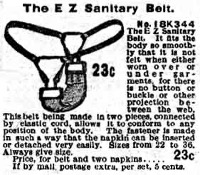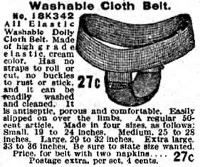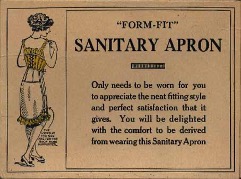Disclaimer: Many of the sources relating to periods in the 18th, 19th and 20th century are Anglo-American, which by no means represents the universal history of periods.
Tampons and pads are some of the most used menstrual products – a trip to the pharmacist can quickly confirm this. But these products have only been commercially available for about 100 years: tampons were patented in the 1930s and pads have been sold since the late 19th century. But what were the options before this?
Menstruation throughout history
Interestingly, people today likely have heavier periods than their historical counterparts. This was due to higher rates of illness and malnutrition compared to now, as well as a higher percentage of life spent pregnant. But the abundance of historical sources relating to menstruation is severely limited. If you can think back to the last book you read which mentioned periods, whether fiction or otherwise, you’d likely struggle to name many. Even with the increase of female authors these days, the mention of periods in media is extremely limited. To find historical mentions of periods is ever rarer, making reliable information difficult to find. And since menstruation is predominantly a ‘women’s issue’, the amount of research that was and is being conducted into it is worryingly scarce. However, there are some sources available.
Nancy Friendman describes the different versions of tampons found, before they were made commercially available, in her book ‘Everything You Must Know About Tampons’ (1981). The Ebers Papyrus, an Egyptian scroll about medical herbal knowledge, describes tampons made of soft papyrus, women in ancient Japan used ones made of paper held in place with a bandage and Roman women used wool tampons. She also writes that “Traditional Hawaiian women used the furry part of a native fern called hapu’u; grasses, mosses and other plants are still used by women in parts of Asia and Africa.” [1]
The 18th Century [2]
Sources from the 18th century show that pain relief was found in warm and cool compresses, made with a mixture of water and vinegar (the latter of which kept the compress cooler) which were applied to the abdomen and back. Salves were made for swelling and inflammation, and teas and tinctures were used to manage headaches, stomach issues and other pain. Stronger alternatives included alcohol and laudanum. Underwear was not commonly worn, due to the large number of layers that made up a woman’s outfit. Free-bleeding was an option for those with lighter periods, but wouldn’t have been possible for all, due to the risk of staining clothes and shoes. Abby Cox, a fashion historian and youtuber, attempted to recreate an 18th century menstruation garment – a linen apron which was brought through the legs and tied up. Linen made specifically for diapers was available in this period and was more absorbent than the regular kind. The width of the apron allowed for layering of the fabric, increasing its absorbency. The petticoat fabric that would have been worn as the bottom-most layer was also quite absorbent, minimising the possibility of stains and leaks.
The 19th Century [3] [4]
Most of the sources we have about periods from this time are from medical articles and advertisements. The medical articles, primarily written by men (with no personal experience of periods) depict menstruation as a disease. Their view was that one should rest and minimise physical activity during periods. But there are no recorded diary entries of higher-class women detailing anything of the sort and working-class women certainly wouldn’t have had this option, so it is unlikely this advice was heeded. In addition to homemade period products, an increase in commercial products could also be seen throughout the century.



The advertisements for period products included an early version of the ‘sanitary belt’ [7] – a belt to which cloths could be attached to and swapped out during use. During this period, underwear typically had an open crotch, as split drawers made it much easier to go to the bathroom as a woman due to the large number of lower layers, so a belt like this would be needed to keep this cloth in place. Handmade tampons were used and were made by wrapping sheep’s wool in cotton. In the latter part of the 19th century, sanitary belts became more prevalent, as did sanitary aprons, which were worn under skirts to protect them from staining. Sea sponges, sold as ‘menstrual sponges’ might have also been used historically, but can no longer be legally sold in the USA, and are not commonly sold elsewhere.
The 20th Century [8] [9]
During the 20th century Earle Haas patented the first applicator tampon, Tampax. The rights to the patent were bought by Gertrude Schulte Tendreich, who continued to grow the company. This followed the first commercially available sanitary pads, which were sold from around 1880, with further iterations being released throughout the early 20th century. During this period there was shift towards commercial menstrual products, rather than homemade ones.
Conclusion
The variety of period products that existed historically was hugely
varied, and this variety has continued today. There is no doubt that fashion
played a role in the development of these products, as it does now, and it will
be fascinating to see how they continue to evolve – especially seeing the rise of
sustainable alternatives.
[1] https://www.straightdope.com/21343395/who-invented-tampons
[2] Abby Cox, I Tried Using an 18th Century Menstruation “Pad”
[3] Bernadette Banner, How Did They Pee in Those Dresses? A Superficial History of Underwear https://www.youtube.com/watch?v=E6G_lID4OLg
[4] Karolina Żebrowska, How Did Victorian Women Deal With Their Periods?
[5] Advetisements from Sears, Roebuck Catalogues, 1902-1908. Via the Museum of Menstruation
[6] Advetisements from Sears, Roebuck Catalogues, 1902-1908. Via the Museum of Menstruation
[7] Apron Illustration, Sears Catalogue, 1914. Via the Museum of Menstruation
[8] https://tampax.com/en-us/about/our-story/history-of-tampax/
